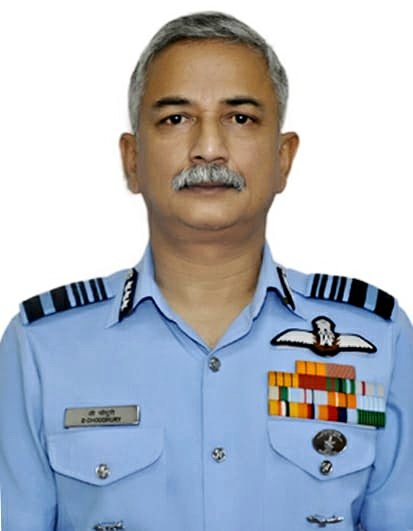does these patches are produced officially per mission/ squadron or as per individual's choice?








if they have airframe life left in them, they are fine to patrol the bangladesh area...?Rakesh wrote:The youngest MiG-21bis is 32 years old. The bis production ended at HAL in 1987. Those MiG-21 squadrons that remained as bis were probably not worth upgrading. But the question remains, why are they still flying then?
Well technically, nothing (AFAIK) prevents the Govt from continuing the work of the Govt which is to make such decisions, because till the next Govt comes in, current guys are in charge. Now, these kind of things will require major inspection, price negotiation etc so won't get done early. But orders for ammo, spares etc would be ongoing.Rakesh wrote:GE Season in India. No acquisition of anything will happen till GE is over.MeshaVishwas wrote:Short of fighter planes, IAF eyes 21 MiG-29 jets and air-defence aircraft
https://m.hindustantimes.com/india-news ... O_amp.html
Rakesh, MiG21 had 2400 hrs of Airframe life. It was planned to be increased by 1600hrs more but the Air frame could clear Fatigue test till only 3400hrs. But based on actual utilization if the number of hours are still not reached the limit, they might have extended the life in terms of number of years, which is OK.Rakesh wrote:The youngest MiG-21bis is 32 years old. The bis production ended at HAL in 1987. Those MiG-21 squadrons that remained as bis were probably not worth upgrading. But the question remains, why are they still flying then?
No.21 "Ankush" squadron moved to Bison long ago. Wiki is not updated. And there are only 2 MiG-27UPG squadrons left now.Aditya_V wrote:There are aldready 272 (-8 attrition) Su-30 MKI + 18 more MKIs will be delivered by next year. Why 272 Aircraft will make only 12 squadrons? Each one of these Birds bring a lot of capability. I don't see more than 18 to a squadron.
Wiki still has MiG-21Bis for Squadron 21 and MiG-27ML for Squadron 22, have these Squadrons been number plated like many other squadrons?
Not at all! The officer must have participated in an exercise with the USAF against USAF pilots flying F-16s. And they came up with that patch almost tongue in cheek.negi wrote:It's most probably a case of lack of creativity ; someone must have googled for patch designs and generally Massan stuff comes first must have simply lifted the concept from there.
Having known how things work I would go with my perception ; besides there is nothing tongue in cheek there .Kartik wrote:Not at all! The officer must have participated in an exercise with the USAF against USAF pilots flying F-16s. And they came up with that patch almost tongue in cheek.negi wrote:It's most probably a case of lack of creativity ; someone must have googled for patch designs and generally Massan stuff comes first must have simply lifted the concept from there.
The airframes should be OK if not operated for prolonged periods in places like jamnagar or anywhere else near/on the coast.Singha wrote:the engines of Mig21 and Mig27 is the problem area. rest of the airframe would be reasonably ok.
most of the crashes that occur in routine flying of these two types are engine problems.
and unfortunately they are 1 engined.
there have been plenty of engine issues on su30 as well but fortunately 2 engines.
maybe thats why russia does not operate any single engine fighter anymore...even frogfoot is 2 engine.
NAL did the fatigue analysis on a MiG-21bis airframe to arrive at a number by which the life could be extended.JayS wrote:Rakesh, MiG21 had 2400 hrs of Airframe life. It was planned to be increased by 1600hrs more but the Air frame could clear Fatigue test till only 3200 or 3600hrs. (I'll put accurate numbers later, don't have the source handy). I think the life was supposed to be over by 2019. But based on actual utilization if the number of hours are still not reached the limit, they might have extended the life in terms of number of years, which is OK.Rakesh wrote:The youngest MiG-21bis is 32 years old. The bis production ended at HAL in 1987. Those MiG-21 squadrons that remained as bis were probably not worth upgrading. But the question remains, why are they still flying then?
For Su30 MKI, it had first overhaul scheduled at 1500hrs or 10yrs whichever was early, but due to underutilization of the Airframes, it was extended to 1500hrs or 14yrs. This should give us a rough matrix to compare with for a frontline IAF fighter. By this standard we can consider 1000hrs = 10yrs roughly. I don't think IAF will in any case fly MiG21 beyond their certified life. They may rather choose to reduce utilization to prolong life in dire situation.
BANGALORE: IAF can heave a sigh of relief.- the life of the MiG-21 Bis has been enhanced. ..
Of course there is. F-16 Aggressor pilots wear this type of MiG-29 Fulcrum patchnegi wrote:Having known how things work I would go with my perception ; besides there is nothing tongue in cheek there .Kartik wrote:
Not at all! The officer must have participated in an exercise with the USAF against USAF pilots flying F-16s. And they came up with that patch almost tongue in cheek.

Hello Jon !
Yes it is exactly what you said - the patch of the USAFE 527th squadron (they had an agressor role). Used when they were flying from RAF Bentwaters in the late 80s (1988-1991 I think, Meathook will probably know loads of toads more than me on this one). Notably, the only USAFE F-16 squadron ever to fly from UK soil.



Tata is Agusta's Indian partner..the then Defence Secretray Vijay Singh approved Agusta VVIP Copter deal is now in Tata Board..and the then Joint Sec (Air) SK Sharma became CAG..MoD officials & Politicians in the deal not even questioned till date...only brokers & IAF guys caught
Meanwhile, place the order for the 83x LCA Mk1A.According to Russian sources, preliminary negotiations took place in January, and delivery terms are now being negotiated. It is not clear yet whether the MiGs bound for India will be freshly assembled using airframe parts from RAC MiG’s stocks or be taken from the Russian army’s storehouses and out of air and space force (VKS) units. The manufacturer is believed to still keep a few “classic” MiG-29 fuselages, but wing components need to be made from scratch. The contemporary Advanced Fulcrum family—comprising MiG-29K/KUB and MiG-29M1/M2 (MiG-35)—is far more expensive and unlikely to meet the budget. Moscow can also offer MiG-29s from the stocks of decommissioned equipment, but restoring redundant airframes with limited lifetime resources may not prove to be a cost-effective proposition.
A more likely scenario is that New Delhi will buy MiG-29SMT/UBT aircraft that are now operational with VKS. These represent the latest versions of the “classic” Fulcrum with larger fuel tanks and improved avionics and mission equipment. The VKS received 34 such aircraft in 2009 (manufactured for Algeria under a 2008 contract, but not accepted by the intended customer) and 14 in 2015/16. Russia was selling such aircraft to foreign clients at an average of $38 million, the figure close to the Indian purchase plan.
First flown in 1977 and operational since 1983, the “classic” MiG-29 had a production run of 1,600 single-seat combat jets and two-seat operational trainers. The type is now considered outdated but still surpasses many in-production fighters in its initial climb rate of 65,000 fpm (330m/sec), g-load factor of 9, and maximum Mach number of 2.35.
I think a Sukhoi squadron is heavy price to pay.Cybaru wrote:Sheesh, just order 50 more MKIs. Mig29s will retire in a decade and half. Another burden to carry just for 21 units for many years after that.
fanne wrote:Please see the hardened pen in Srinagar and Awantipur (from where MIG21 took off). Now you will understand why IAF asked for smallest/lightest LCA, because perhaps only these can fit there (someone like Gagan do a more precise measuring). Mig 29 may fit in, SU30MKI wont. .